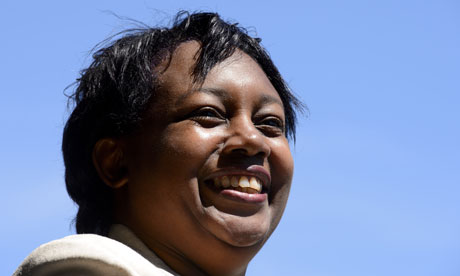When I worked in a bookshop, the absence of brown faces in children's books was striking. I hope now more will appear

Malorie Blackman has been announced as the new children's laureate. Photograph: Jonathan Hordle/Rex Features
Back in the pre-double dip recession mists of time, I worked in bookstore chain Borders. I was lucky to start off in the department of my choice – the children's section – because I had been a bookish child and, romantically, wanted to pass on the lifelong love of reading that had so enriched my own childhood and adolescence.
I joined Newham Libraries as a very young child, and with my sister and parents made weekly trips to the Manor Park branch to read and borrow books and cassettes. As a pre-teen in Lagos, my dad insisted on giving us a book allowance, separate and distinct from our usual pocket money, which was to be spent exclusively on the written word. It was a wide remit, so included comics (before they were called "graphic novels" – my first was Marvel's Ghost Rider) and sometimes magazines (although my dad generally frowned on these) and novels. I read everything, and then a second time, as I waited for new books to arrive.
The majority of the characters in the books I loved were white. There's just no getting away from this. Through them, I very quickly learned (thanks to the context, and then a dictionary) what it was to blush, or to "go purple with rage". I understood that these were not things I could do; my body would not allow it. In these books, children went on adventures in the summer holidays, getting under the feet of their parents and guardians and being urged to go and play outside.
There was magic in these books too: faraway trees, enchanted woods and worlds beyond wardrobes and looking glasses. I rarely encountered a single character who was a person of colour, and when they were they were very often the bad guy – their non-whiteness a signal for their morally bankrupt insides. You notice it as a child, and even though you shrug it off it lingers at the back your mind, perhaps unconsciously. I remember that a lot of the stories I made up featured characters who looked like the Famous Five, even when I was living incredibly close to the equator, surrounded by kids of all shades of brown. The Nigerian author Chimamanda Ngozi Adichie recalls writing about characters who played in snow and drank ginger beer.
Years later, selling stories to kids, I noticed that regardless of genre, there was still a dearth of brown faces and voices in children's literature. We got our diktats from head office on what was on promotion "3-for-2" that week, or the movie tie-ins we were looking to push, but then we were given "free" displays to fill as we pleased. That's when the scramble would begin, trying to find books with a black or Asian character, and then even more stringently, one that was a lead, and written as a complex, non-stereotypical creature.
More
I joined Newham Libraries as a very young child, and with my sister and parents made weekly trips to the Manor Park branch to read and borrow books and cassettes. As a pre-teen in Lagos, my dad insisted on giving us a book allowance, separate and distinct from our usual pocket money, which was to be spent exclusively on the written word. It was a wide remit, so included comics (before they were called "graphic novels" – my first was Marvel's Ghost Rider) and sometimes magazines (although my dad generally frowned on these) and novels. I read everything, and then a second time, as I waited for new books to arrive.
The majority of the characters in the books I loved were white. There's just no getting away from this. Through them, I very quickly learned (thanks to the context, and then a dictionary) what it was to blush, or to "go purple with rage". I understood that these were not things I could do; my body would not allow it. In these books, children went on adventures in the summer holidays, getting under the feet of their parents and guardians and being urged to go and play outside.
There was magic in these books too: faraway trees, enchanted woods and worlds beyond wardrobes and looking glasses. I rarely encountered a single character who was a person of colour, and when they were they were very often the bad guy – their non-whiteness a signal for their morally bankrupt insides. You notice it as a child, and even though you shrug it off it lingers at the back your mind, perhaps unconsciously. I remember that a lot of the stories I made up featured characters who looked like the Famous Five, even when I was living incredibly close to the equator, surrounded by kids of all shades of brown. The Nigerian author Chimamanda Ngozi Adichie recalls writing about characters who played in snow and drank ginger beer.
Years later, selling stories to kids, I noticed that regardless of genre, there was still a dearth of brown faces and voices in children's literature. We got our diktats from head office on what was on promotion "3-for-2" that week, or the movie tie-ins we were looking to push, but then we were given "free" displays to fill as we pleased. That's when the scramble would begin, trying to find books with a black or Asian character, and then even more stringently, one that was a lead, and written as a complex, non-stereotypical creature.
More

No comments:
Post a Comment